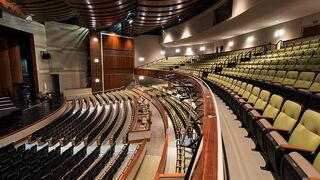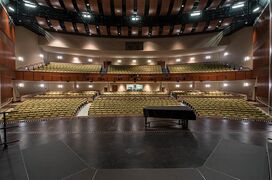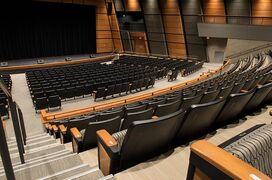Code Considerations And Fire Safety For Auditoriums
By Anne Chapman
September 16, 2020

One of the most important commitments an auditorium designer has is ensuring the safety of those who will use the space. According to the NFPA, fires in theaters and auditoriums without proper safety systems are among the most deadly. Adhering to the latest best practices can make fires less likely in the first place, and make evacuations safer and easier in the event of an emergency. Read on for important considerations:
Historic Code Versus The Current General Code (IBC)
Understanding the most recent code requirements means designers can create a space that complies with safety laws. The Historic Code applies to places like historic performance halls, and it has very specific spacing requirements. For instance, under historic conventional seating rules, you can have no more than 14 chairs between legal aisles and up to seven chairs between an aisle and a wall.
The current general version of the International Building Code (IBC) works from a different model. It's formula-based, working to create efficient designs that allow flexibility for designers and architects. IBC is the code that most suppliers will default to unless an alternate code is laid out. Make sure you understand which code you are working with before you start.
Common Layouts

The seating configuration in your auditorium affects your capacity for guests, as well as your guests' safety, comfort, and enjoyment of the event. There are many things to consider when choosing a seating configuration. The most common seating configurations include:
- Continental seating: This seating configuration uses curved rows with aisles on two sides. Historic code is usually used in these spaces.
- Straight row seating: This is the seating configuration you are most likely to see in historic auditoriums. While this configuration's sightline issues mean that it is not used often now, it is sometimes the best choice for very small venues.
- Multiple aisle seating: This arrangement uses a combination of straight row and continental seating, paired with features like risers, staggered chairs, and sloped floors to give every patron the best view. The IBC's code allows for custom-designed spaces that meet safety requirements without sacrificing space or audience comfort.
Choosing the right seating arrangement for your intended space will include considerations like the type of stage, the size of your space, and meeting requirements like fire safety codes. A qualified seating layout engineer can help you make the most of any space.
Common Fire Safety Issues
When local fire marshals and other code officials inspect buildings like auditoriums, there are a number of infractions that they report encountering again and again. Keep an eye out for these common fire safety issues in your facility:
- Blocked fire department connections: When a fire occurs, quick response is key to containing it. When branches, pallets, vehicles, or other items obstruct the path, it can cost valuable time.
- Incorrect fire sprinkler systems: When a building's purpose changes, its sprinkler system needs to be updated to fit the new use.
- Items stored improperly in the fire pump and riser rooms: These are spaces reserved for fire protection equipment. When other items like file cabinets find their way in there, it can make it harder for firefighters to do their jobs.
- Improperly fire-proofed seating: Older seating may not be up to current flammability requirements, making them a fire hazard.
- Improper seating spacing: Failing to provide enough access to egresses can make it harder for guests to evacuate if there's an emergency. Make sure that you are using the right codes for seat spacing and access to aisles.
Being aware of these fire safety basics can keep you on the right side of the fire marshal during inspections and help you ensure your guests have a safe and enjoyable time.
Use Only Fire-Tested Fabrics
The fabrics and foam used in the production of seats, curtains, and other items must pass flammability tests. All fabrics and foam currently used by Irwin Seating Company pass requirements that include NFPA 260, CAL-177, and CAL-177-2013. We keep certificates of compliance available in case your fire marshal requires a copy.
Closing Thoughts

Making sure auditorium spaces are up to code from the get go means far less worry later on. Failing to comply with code could result in costly renovations at best or serious injury at worst. Because of this, it is vital to work with experts who are familiar with every relevant fire safety code and in a position to ensure that they are met while giving your guests an excellent event experience.